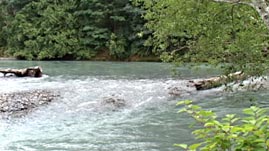Teachers' Domain - Digital Media for the Classroom and Professional Development
User: Preview

Source: A Northwest Indian College production for NASA's Where Words Touch The Earth



This video segment features Native American Elders discussing the impact of climate change on salmon populations and the importance of restoring balance in the natural world. A Native educator describes having taken students to a river's headwaters to watch salmon spawn, only to observe the deadly effects of water temperature rise on the fish eggs. She explains that even a small change in temperature can result in a population decline that could threaten Native peoples and their way of life. The video segment was adapted from a student video produced at Northwest Indian College in Bellingham, Washington.
The Lummi Nation of northwest Washington State is a fishing nation. The Lummi people have traditionally relied on Pacific salmon and shellfish as the basis for their subsistence diet. In the past, the local salmon population has been healthy and plentiful. Adult fish were harvested when they returned from the ocean to inland waterways to reproduce. However, in recent decades, the population has dwindled due to various environmental factors—so much so that the balance that characterizes the traditional Lummi way of life has been threatened.
Salmon are anadromous fish, which means they spend most of their adult life in saltwater, but reproduce, or spawn, in freshwater. They are born in freshwater systems, swim out to the ocean for two to six years, and, once mature, return to spawn in the same freshwater where they were born. The eggs, which are deposited by a female and fertilized by its paired male, develop in a gravel bed until they hatch, which typically takes place in the late winter or spring.
Salmon are sensitive to environmental changes in both their freshwater and marine ecosystems. Like many other species of fish, they are susceptible to overfishing, habitat destruction, and changes in water temperature, stream flow, and pollution. These factors directly impact the overall health of their populations, and indirectly impact other members of the ecosystem.
As the video explains, salmon eggs are particularly sensitive to external factors. In fact, only 1 in 10 normally survives to hatch. Salmon eggs lack a hard shell. Instead, they have a soft, transparent wall, or membrane. This provides scant protection against predators or other disturbances. The eggs need clean water that contains dissolved oxygen and little or no silt. The water must also be cold—the ideal temperature for salmon egg development is between 41ºF and 48ºF (5ºC and 9ºC). While salmon eggs can develop at lower temperatures, warmer water impedes growth. It causes salmon metabolism to increase, which takes energy away from growth and leads to earlier egg hatching. This not only exposes the tiny fish to predators, but makes it difficult for them to find food, as their usual food source—insects—may not yet be hatched. If water temperature exceeds the range by a few degrees or more, it can kill the eggs even before they have a chance to hatch.
Both tribal Elders and scientists are worried that these changes within the ecosystem might outpace the salmons’ ability to adapt. To help prevent population collapse, needed steps might include maintaining shade cover to minimize increases in water temperature, and promoting a forest structure that retains melt water and thereby stabilizes river flow levels. Removing dams, another negative factor to salmon health, would allow salmon to migrate and spawn in better thermal conditions, as dams themselves increase water temperatures.
 Loading Standards
Loading Standards Teachers' Domain is proud to be a Pathways portal to the National Science Digital Library.
Teachers' Domain is proud to be a Pathways portal to the National Science Digital Library.
